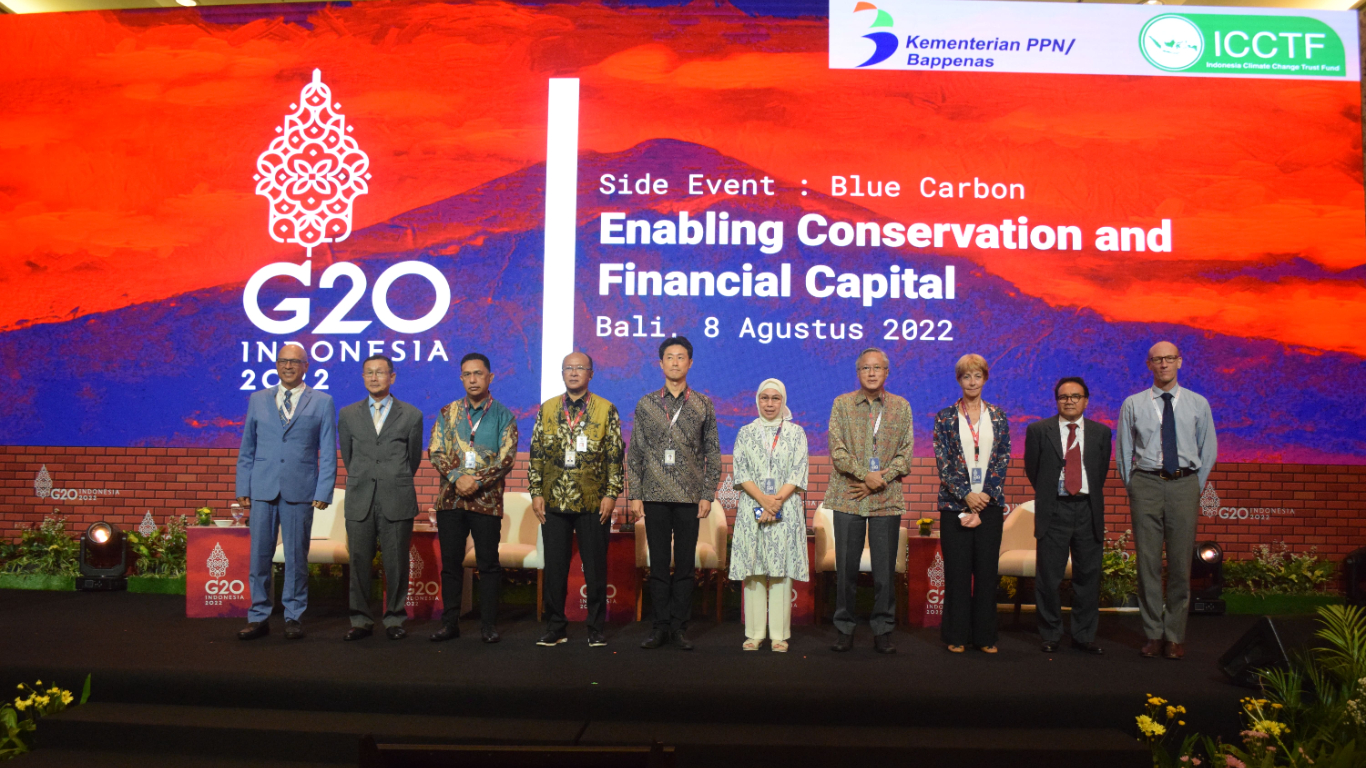Bappenas Prioritizes Blue Carbon Ecosystem Conservation
Prime News - Tue, 09 August 2022

As a country that hosts a substantial number of mangroves and seagrass beds, Indonesia is encouraging a blue carbon ecosystem development in spatial management planning and coastal conservation efforts domestically and globally.
Indonesia is a home to around 3.3 million hectares of mangroves and 293,000 hectares of seagrass. These two coastal ecosystems are able to act as massive carbon sinks, with up to 3.3 gigatons or 17% of global blue carbon being able to be stored in these ecosystems. However, the increasing destruction of coastal ecosystems has the potential to release and exacerbate the amount of carbon dioxide going into water systems, equivalent to 19% of emissions related to tropical forest destruction.
“Implementing the national strategy and managing the enormous potential of the blue carbon ecosystem in Indonesia cannot be done without coordination and integration with ministries and other key stakeholders related to blue carbon management. There is a need for a set of guiding standards in the management of blue carbon ecosystems at the regional and national levels, as well as policy documents that form the legal basis for the implementation of blue carbon management in Indonesia,” explained the Ministry of National Development Planning/Bappenas’ Chief of Planner Arifin Rudiyanto, who is also representing the Ministry’s Deputy for Maritime Affairs and Natural Resources at the “Blue Carbon: Enabling Conservation and Financial Capital” G20 Development Working Group side-event in Bali on Monday (8/8).
To rehabilitate their increasingly damaged blue carbon ecosystems, the Indonesian government is committed to ensuring that the blue carbon ecosystem is listed as a Nationally Determined Contribution (NDC). Shaping guidelines for the management of blue carbon ecosystems is a priority task that is included within the 2020-2024 National Medium-Term Development Plan and three other development programs made by the government. The implementation of the national strategy requires institutional and policy aspects that include enabling environmental regulations and national protocols for blue carbon strategies and action plans, as well as the basic data needed for NDC targets. If the blue ecosystem is managed strategically to foster climate resilience, Indonesia is able to contribute more to reducing greenhouse gas emissions by 29% nationally, and 41% globally by 2030.
Arifin also emphasized the importance of developing a framework for the implementation of all activities related to blue carbon, including the financing. Blue carbon projects are able to utilize regular financing schemes such as loan grants and the State Budget (APBN). In addition to this, financers can also use innovative methods sourced from the blue carbon projects themselves.
“The potential of blue carbon can be included in a carbon trading mechanism that sells graded carbon. The benefits of this trade can be used to finance several sectors such as fisheries, conservation efforts, renewable energy, waste management, marine transportation, and ecotourism, as well as financing conservation and restoration projects for blue carbon ecosystems,” Arifin explained.
Also present as a speaker at the discussion, the Agence Francaise de Development (AFD)’s Deputy Country Director for Indonesia Sophia Chappellet said that the AFD supports the Indonesian government’s efforts in managing blue carbon ecosystems, one of which is through the integration of blue carbon ecosystems into biodiversity and climate policies. As part of its concrete support, the AFD is committed to providing funding for the implementation of blue carbon ecosystems in Indonesia.
The “Blue Carbon: Enabling Conservation and Financial Capital” was also attended by the Counsellor for Development Effectiveness and Sustainability Department at the Australian Embassy to Indonesia’s Department of Foreign Affairs and Trade Simon Ernst, the Interim Dean of the Alfred J. Verrecchia-Hasbro Leadership Chair and Chair of the University of Rhode Island’s College of Business Prof. Shaw K. Chen, and one of the Ministry of National Development Planning/Bappenas’ Chief of Planner Gellwynn Jusuf. During the event, these figures discussed blue carbon management lessons and solutions.
About the Development Working Group
The Development Working Group (DWG) is one of the working groups of the 2022 G20 Indonesia Presidency which aims to discuss development issues in developing countries, least developed countries (LDC) and island countries (Small Island Developing States/SIDS). The DWG was first formed at the 2010 G20 Summit in Toronto, Canada with the main task of discussing the G20 priority agendas in the field of development. The DWG identifies development challenges, and then formulates the best solutions to promote economic growth in developing and low-income countries as an effort to mitigate the global financial crisis.
During the Indonesian Presidency of the G20 in 2022, the DWG raised four priority issues, namely:
1) Strengthening Recovery from the Covid-19 Pandemic and Ensuring Resilience in Developing Countries, Underdeveloped Countries, and Archipelagic Countries through the three key pillars of MSMEs, Adaptive Social Protection, and Low-Carbon Green and Blue Economies
2) Increasing Private and Blended Financing in Funding Sustainable Development in Developing Countries, Underdeveloped Countries, and Archipelagic Countries
3) Renewing the Global Commitment to Multilateralism for Sustainable Development
4) Coordinating the progress of achieving the SDGs in the G20 and updating the G20 Development Commitments.
The DWG’s focal points, organized by the Ministry of National Development Planning/Bappenas, are the 1st DWG Meeting in Jakarta (24-25 February) and the 2nd DWG Meeting in Yogyakarta (24-25 May). A third DWG meeting will be held in Bali between 10 August to 12 August 2022. The G20 Indonesia Presidency will also hold the G20 Development Ministerial Meeting in Belitung on 7-9 September 2022.
